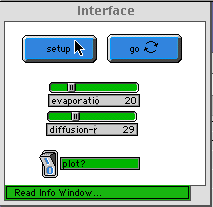
WHAT IS IT? ----------- In this project, a colony of 100 ants forages for food. Each ant follows a set of simple rules, but the colony as a whole acts in a sophisticated way. When an ant finds a piece of food, it carries the food back to the nest, dropping a chemical as it moves. When other ants "sniff" the chemical, they follow the chemical toward the food. As more ants carry food to the nest, they reinforce the chemical trail. HOW TO USE IT ------------- Click the SETUP button to set up the ant nest (in violet, at center) and three piles of food. Click the GO button to start the simulation. The chemical is shown in a green-to-white gradient. The EVAPORATION-RATE slider controls the evaporation rate of the chemical. The DIFFUSION-RATE slider controls the diffusion rate of the chemical. THINGS TO NOTICE ---------------- The ant colony generally exploits the food source in order, starting with the food closest to the nest, and finishing with the food most distant from the nest. It is more difficult for the ants to form a stable trail to the more distant food, since the chemical trail has more time to evaporate and diffuse before being reinforced. Once the colony finishes collecting the closest food, the chemical trail to that food naturally disappears, freeing up ants to help collect the other food sources. The more distant food sources require a larger "critical number" of ants to form a stable trail. The consumption of the food source is shown in a plot window. In CYAN you see food1 which is on the right side of the screen. In BLUE you see food2 which is on the lower left of the screen. In MAGENTA you see food3 which is on the upper left of the screen. EXPLORATIONS ------------- Try different placements for the food sources. What happens if two food sources are equidistant from the nest? When that happens in the real world, ant colonies typically exploit one source then the other (not at the same time). In this project, the ants use a "trick" to find their way back to the nest: they follow the "nest scent." Real ants use a variety of different approaches to find their way back to the nest. Try to implement some alternative strategies. STARLOGOT FEATURES ------------------- In the UPHILL-CHEMICAL procedure, the ant "follows the gradient" of the chemical. That is, it "sniffs" in three directions, then turns in the direction where the chemical is strongest. You might want to try variants of the UPHILL-CHEMICAL procedure, changing the number and placement of "ant sniffs." The new StarLogoT uphill primitives can be used to replace the specialized uphill procedures. RETURN-TO-NEST uses a similar gradient. CREDITS and REFERENCES ----------------------- This model was adapted from the ants model at the MIT Media Lab. See Resnick, M. (1994) "Turtles, Termites and Traffic Jams: Explorations in Massively Parallel Microworlds." Cambridge, Ma: MIT Press. Adapted to StarLogoT, 1997, as part of the Connected Mathematics Project.